Repair of an RCA Radiola 26
© 2009, Richard Fairbanks
|
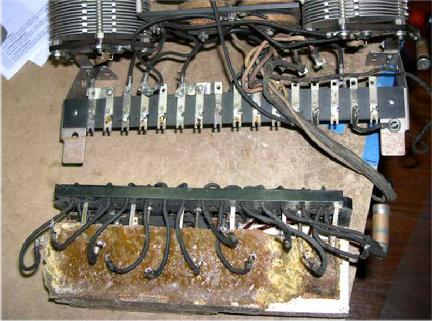 |
| After unsoldering, the catacomb comes apart |
|
|
To get inside the catacomb, all “whiskers” are disconnected. A couple of screws are removed from each end of the catacomb to free it from the radio's frame. To my surprise the can's seals are already broken. Someone has been in here before! The words “mint condition” echo through my mind and I start grumbling.
|
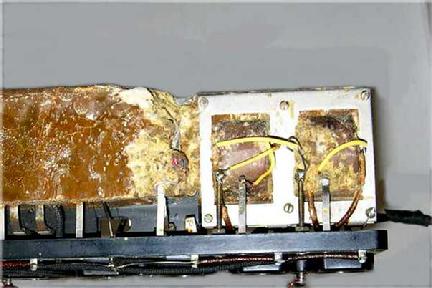 |
| A previous repair to the audio transformers is visible |
|
|
The brownish block of wax into which RCA’s precious circuitry was buried decades ago has been chipped away at one end, apparently to gain access to the audio transformers. I am more interested in an IF transformer that is still buried. Rather than chipping at the wax to find it, melting is a much safer approach.
|
I attach a wire “handle” to some screws that originally held a cover over the tube sockets, and lower the block back into its metal can.
The catacomb is shoved into the oven like a roast for several hours at about 375 degrees. The smell is not at all unpleasant, strong and sweet, more like fresh pine tar, but I am very glad it is a nice day and I can open all the windows.
|
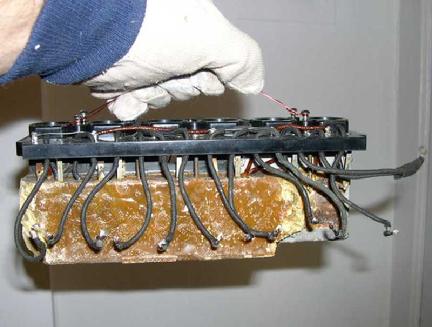 |
| A wire handle is attached |
|
|
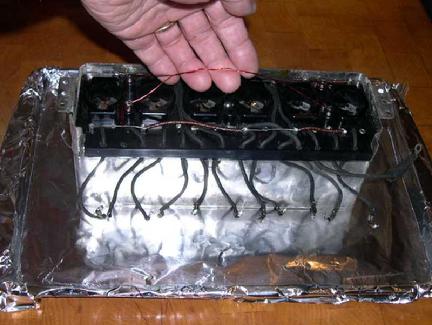 |
| Ready for the oven! |
|
|
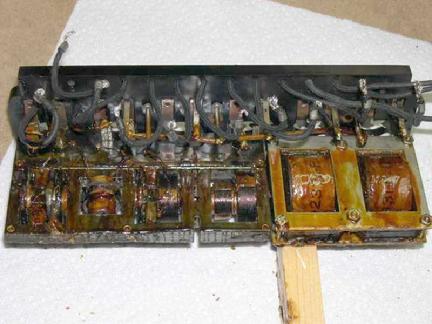 |
| The mysterious circuits emerge |
|
|
Slowly most of the waxy resin drains into the bottom of the can. As the goo liquefies, coils, transformers, and capacitors emerge. My improvised handle makes it easy to lift the assembly up for a check.
Access success! Before the goo hardens, as much as possible is drained into another container and the can cleaned with denatured alcohol. Solvents like Naptha work better but alcohol seems more environmentally friendly.
In contrast to the neat wiring elsewhere in the radio this is a mess! Frail little wires dart between transformers and snake all around the assembly. No wonder RCA wanted to hide it in a block of waxy goo!
|
|
|
I can see one of those tiny wires has broken midway along its journey. A dab of solder fixes the break and repairs our 2nd IF stage. That was easy! Wouldn’t it be nice if the oscillator works now also? I reconnect those coils I resonated earlier to the appropriate whiskers, but the oscillator remains flat lined. I check and recheck point by point through the circuit, testing every single part, only to turn up empty. Everything appears as it should and yet the oscillator is dead. My mouth hangs open with disbelief. There just has to be something I’ve overlooked!
|
|
| According to Alan Douglas’ schematic, two transformers are designed with “tickler” windings. Unlike most coils, ticklers are connected on only one end and pass no DC current whatsoever. They function like miniature transmitting antennas inside the transformers to provide "feedback". In this layout, the unused tickler ends are simply soldered to little posts that have no other function. Many hair-thin wires are really hard to follow through blobs of goo but it looks to me like one of them touches one of those posts. It shouldn't!
Could there possibly be an unwanted contact? A heat gun on a waxy blob releases the wire and I hold it in a new position as the wax hardens again. It won’t hurt to check every other wire as long as I'm at it, to be absolutely certain no other unintended connections will ever be possible. The oscillator works perfectly now.
|
I’ve learned that most of the little wax blobs require considerable heat to melt, enough to cause occasional smoke and stink. I decide to NOT re-melt the old goo and re-pot the catacomb; those tiny wires are too fragile to risk it. The catacomb will be perfectly fine just the way it is, well protected by its metal box, and a pound or so less heavy.
next-->
|
|
|